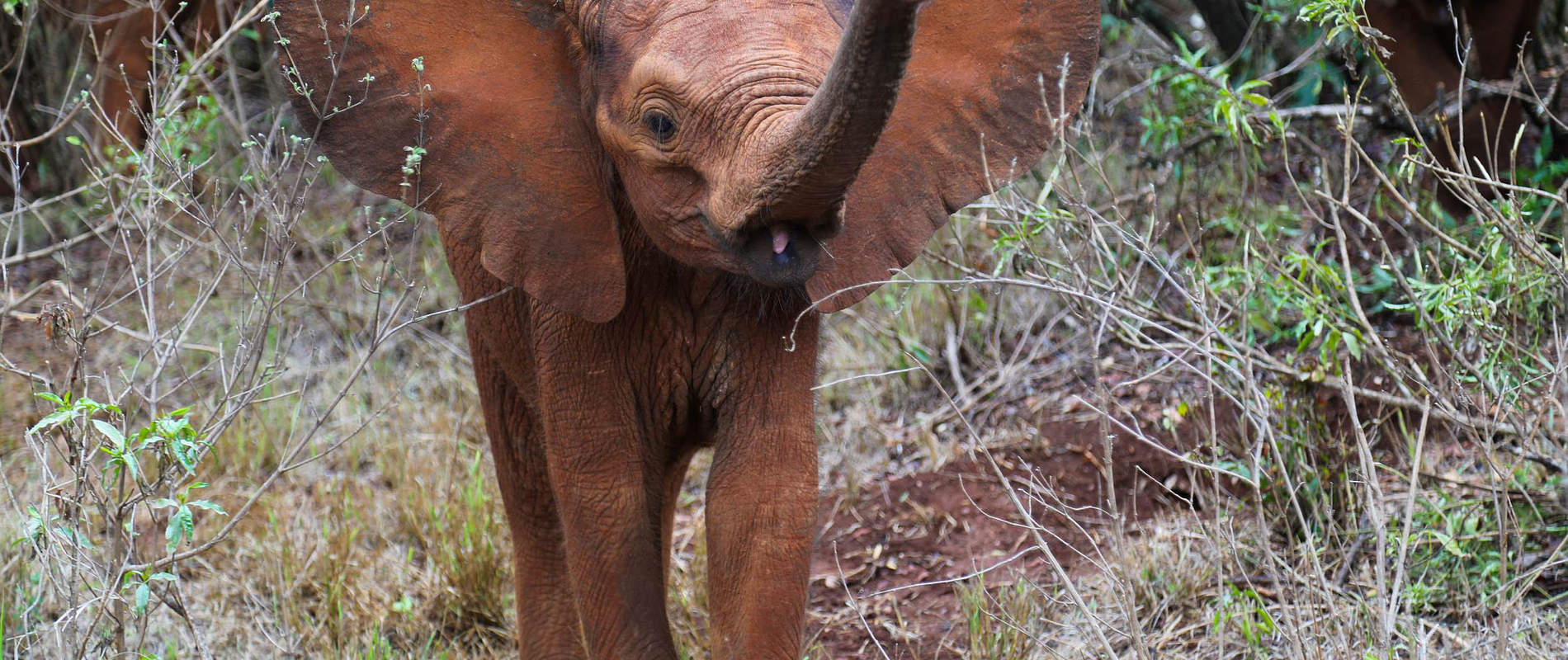On the 15th of March a Tsavo Trust vehicle was driving in Tsavo East National park in an area known as the Triangle, a sector of the Park between the Athi River and the Mombasa Nairobi highway, their mission to retrieve ivory from a carcass sighted from the air earlier in the day
On the 15th of March a Tsavo Trust vehicle was driving in Tsavo East National park in an area known as the Triangle, a sector of the Park between the Athi River and the Mombasa Nairobi highway, their mission to retrieve ivory from a carcass sighted from the air earlier in the day.
On their way back they found a tiny baby elephant wandering around on its own near the road. It is difficult to know if the carcass was that of the mother, but it would appear likely given the proximity of the two, despite the fact that the carcass looked a few weeks old. The calf was in an emaciated condition indicating she had been on her own for quite some time before being rescued having been restrained and captured, and then loaded into the landcruiser and brought to the Trust’s Field Headquarters at Kaluku adjacent to the Triangle. (Kaluku is where our aerial support operates from, and where the Trust Pilots live). It was well after dark by the time the team arrived at Kaluku, and it required many able bodies to off- load the calf, get her back to her feet, and ensure she received some water. The only place available to keep her restrained for the night was in Humpty the hippo’s recently constructed stable. Humpty is an adorable baby hippo who was rescued just before Christmas day, and has since made Kaluku her home. She has a customized pool and fortunately that evening had chosen to remain in her pool for the night, relinquishing her stable for the newcomer. Despite being very thin, the baby elephant still had fight, no doubt bolstered by adrenaline, so not much else could be done for her that night.

In the meantime the Nairobi HQ had been alerted about the baby and a rescue plane and a team of Keepers were coordinated by Angela Sheldrick, set to depart first thing in the morning in order to head down to Tsavo. A further report received first thing on the 16th confirmed that the calf was alive and well, and so the team departed, arriving at Kaluku at around 10 am in the morning. They were greeted by a curious Humpy aware that the usual routines had been turned upside down. The stable door was opened and the team was able to encourage the calf to drink before preparing her for the flight to Nairobi. All the while this was going on, Humpty was mooching around surveying the scene, extremely interested in the unusual proceedings. The men were grappling with a young elephant calf, while the tiny pint-sized hippo circled curiously, and some of the Trust’s other orphaned animals at Kaluku which included a duiker and kudu, watched from a safe distance. We estimated the elephant calf to be around 10 months old, very much still milk dependent, and without such timely intervention would have died of starvation. One could not help but reflect on the terrifying days and nights she had spent out there before help arrived, alone and vulnerable, fearing for her life, and just how fortunate she was to be sighted. And at first the help she was about to receive must have been terrifying, but elephants are incredibly intelligent animals, and so it would not be long before she would understand that, in fact, she was being helped.



The elephant calf was loaded onto a Cessna Caravan on the Trust’s Kaluku airfield, and without much delay she was on her way to Nairobi where she could receive the intensive care she needed given her precarious state. Upon arrival at the Nursery at midday she remained aggressive, charging at the Stockade Gate, but with freshly cut greens available and fresh water, she settled down to feed, clearly desperate for food. Tsavo in March was tinder dry after a lengthy drought, so for her to suddenly have so much vegetation at her disposal was, indeed, a treat. At one year old, however, greens alone could not sustain her life so it was important that she got hooked on her milk rapidly, the Keepers persevering with this. We brought the other orphans around to meet her in her Stockade in the afternoon, as this is the best balm of all for new arrivals, the Nursery orphans able to impart positive vibes and communicate with a newcomer that there was nothing to fear.



By evening, the new calf was visibly calmer, her next door neighbor being Karisa at the time. Soon she began taking her milk from a hand-held bottle, tolerating the presence of a Keeper in her Stockade and as the days passed she would come to the Keepers and gain comfort sucking their fingers. In a very short time our little calf was calm enough to head out into the Nairobi National Park with the other elephant orphans to browse and wander around at will doing what elephants do all day, free from the confines of the stockade. We called her Mteto, after the Mtito Andei village, not far from where she was found.




The day she joined the others in the forest was a happy day for this friendly little calf, calm and relishing the companionship she appeared to learn the ropes from the outset. Seamlessly she slotted into the herd, even heading off to the public viewing one hour between 11a.m. and 12 noon, such was the confidence the rest of the orphans were able to impart. Since then Mteto has thrived, has gained condition, and is now totally settled and happy having made a number of very special friends within the fold.

















